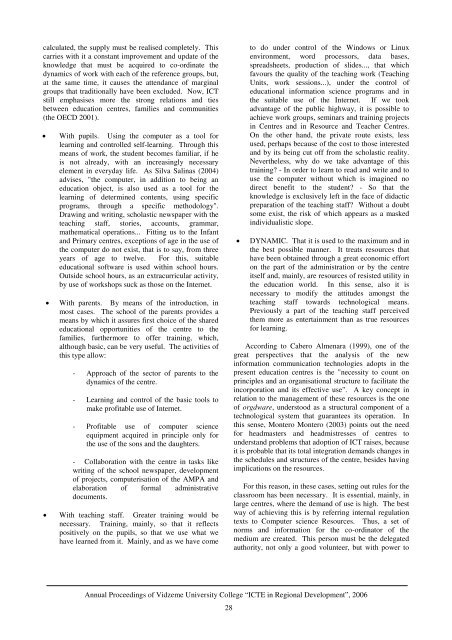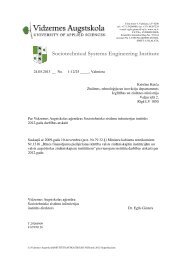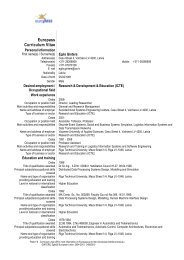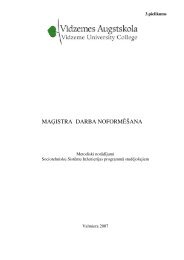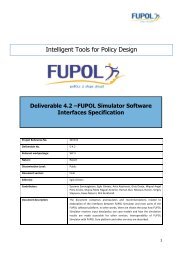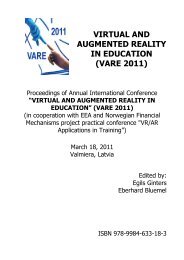calculated, the supply must be realised completely. Thiscarries with it a constant improvement and update of theknowledge that must be acquired to co-ord<strong>in</strong>ate thedynamics of work with each of the reference groups, but,at the same time, it causes the attendance of marg<strong>in</strong>algroups that traditionally have been excluded. Now, ICTstill emphasises more the strong relations and tiesbetween education centres, families and communities(the OECD 2001).• With pupils. Us<strong>in</strong>g the computer as a tool forlearn<strong>in</strong>g and controlled self-learn<strong>in</strong>g. Through thismeans of work, the student becomes familiar, if heis not already, with an <strong>in</strong>creas<strong>in</strong>gly necessaryelement <strong>in</strong> everyday life. As Silva Sal<strong>in</strong>as (2004)advises, "the computer, <strong>in</strong> addition to be<strong>in</strong>g aneducation object, is also used as a tool for thelearn<strong>in</strong>g of determ<strong>in</strong>ed contents, us<strong>in</strong>g specificprograms, through a specific methodology".Draw<strong>in</strong>g and writ<strong>in</strong>g, scholastic newspaper with theteach<strong>in</strong>g staff, stories, accounts, grammar,mathematical operations... Fitt<strong>in</strong>g us to the Infantand Primary centres, exceptions of age <strong>in</strong> the use ofthe computer do not exist, that is to say, from threeyears of age to twelve. For this, suitableeducational software is used with<strong>in</strong> school hours.Outside school hours, as an extracurricular activity,by use of workshops suck as those on the Internet.• With parents. By means of the <strong>in</strong>troduction, <strong>in</strong>most cases. The school of the parents provides ameans by which it assures first choice of the sharededucational opportunities of the centre to thefamilies, furthermore to offer tra<strong>in</strong><strong>in</strong>g, which,although basic, can be very useful. The activities ofthis type allow:- Approach of the sector of parents to thedynamics of the centre.- Learn<strong>in</strong>g and control of the basic tools tomake profitable use of Internet.- Profitable use of computer scienceequipment acquired <strong>in</strong> pr<strong>in</strong>ciple only forthe use of the sons and the daughters.- Collaboration with the centre <strong>in</strong> tasks likewrit<strong>in</strong>g of the school newspaper, developmentof projects, computerisation of the AMPA andelaboration of formal adm<strong>in</strong>istrativedocuments.• With teach<strong>in</strong>g staff. Greater tra<strong>in</strong><strong>in</strong>g would benecessary. Tra<strong>in</strong><strong>in</strong>g, ma<strong>in</strong>ly, so that it reflectspositively on the pupils, so that we use what wehave learned from it. Ma<strong>in</strong>ly, and as we have cometo do under control of the W<strong>in</strong>dows or L<strong>in</strong>uxenvironment, word processors, data bases,spreadsheets, production of slides..., that whichfavours the quality of the teach<strong>in</strong>g work (Teach<strong>in</strong>gUnits, work sessions...), under the control ofeducational <strong>in</strong><strong>format</strong>ion science programs and <strong>in</strong>the suitable use of the Internet. If we tookadvantage of the public highway, it is possible toachieve work groups, sem<strong>in</strong>ars and tra<strong>in</strong><strong>in</strong>g projects<strong>in</strong> Centres and <strong>in</strong> Resource and Teacher Centres.On the other hand, the private route exists, lessused, perhaps because of the cost to those <strong>in</strong>terestedand by its be<strong>in</strong>g cut off from the scholastic reality.Nevertheless, why do we take advantage of thistra<strong>in</strong><strong>in</strong>g? - In order to learn to read and write and touse the computer without which is imag<strong>in</strong>ed nodirect benefit to the student? - So that theknowledge is exclusively left <strong>in</strong> the face of didacticpreparation of the teach<strong>in</strong>g staff? Without a doubtsome exist, the risk of which appears as a masked<strong>in</strong>dividualistic slope.• DYNAMIC. That it is used to the maximum and <strong>in</strong>the best possible manner. It treats resources thathave been obta<strong>in</strong>ed through a great economic efforton the part of the adm<strong>in</strong>istration or by the centreitself and, ma<strong>in</strong>ly, are resources of resisted utility <strong>in</strong>the education world. In this sense, also it isnecessary to modify the attitudes amongst theteach<strong>in</strong>g staff towards technological means.Previously a part of the teach<strong>in</strong>g staff perceivedthem more as enterta<strong>in</strong>ment than as true resourcesfor learn<strong>in</strong>g.Accord<strong>in</strong>g to Cabero Almenara (1999), one of thegreat perspectives that the analysis of the new<strong>in</strong><strong>format</strong>ion communication technologies adopts <strong>in</strong> thepresent education centres is the "necessity to count onpr<strong>in</strong>ciples and an organisational structure to facilitate the<strong>in</strong>corporation and its effective use". A key concept <strong>in</strong>relation to the management of these resources is the oneof orgdware, understood as a structural component of atechnological system that guarantees its operation. Inthis sense, Montero Montero (2003) po<strong>in</strong>ts out the needfor headmasters and headmistresses of centres tounderstand problems that adoption of ICT raises, becauseit is probable that its total <strong>in</strong>tegration demands changes <strong>in</strong>the schedules and structures of the centre, besides hav<strong>in</strong>gimplications on the resources.For this reason, <strong>in</strong> these cases, sett<strong>in</strong>g out rules for theclassroom has been necessary. It is essential, ma<strong>in</strong>ly, <strong>in</strong>large centres, where the demand of use is high. The bestway of achiev<strong>in</strong>g this is by referr<strong>in</strong>g <strong>in</strong>ternal regulationtexts to Computer science Resources. Thus, a set ofnorms and <strong>in</strong><strong>format</strong>ion for the co-ord<strong>in</strong>ator of themedium are created. This person must be the delegatedauthority, not only a good volunteer, but with power toAnnual <strong>Proceed<strong>in</strong>gs</strong> of Vidzeme University College “ICTE <strong>in</strong> Regional Development”, 200628
make decisions. It cannot be voluntary work for shortperiods, which is the reason why a suitable hourly rate ofpay is necessary. It is necessary for him to have tra<strong>in</strong><strong>in</strong>g,qualification, and knowledge. In addition, resources andspaces for the activities of management and tra<strong>in</strong><strong>in</strong>g mustbe allowed for.Moreover, with respect to the tra<strong>in</strong><strong>in</strong>g, where andhow? If it is <strong>in</strong>itial, then it needs a good base <strong>in</strong> theeducation faculties. In addition, the education centresbecome an extraord<strong>in</strong>ary platform for tra<strong>in</strong><strong>in</strong>g if there are<strong>in</strong>telligent management teams, able to facilitate theorganisation of activities like work groups, sem<strong>in</strong>ars thatmeet the present plans of the centres, the necessities ofthe teach<strong>in</strong>g staff based on the new educationalassignments... Another option is to use to the teach<strong>in</strong>gcentres, which lately are mak<strong>in</strong>g the effort to adapt theirmethodologies to the most press<strong>in</strong>g necessities of theschool.REFERENCESBarqu<strong>in</strong>, R., J. 2004. “La implantación de lastecnologías de la <strong>in</strong>formación en la sociedad y en loscentros educativos públicos de la Comunidad deAndalucía”. En Revista Iberoamericana de Educación,nº 36.Bustos J., A. 2002. “El aula de <strong>in</strong>formática al servicio dela Comunidad Educativa”. En La organización de losnuevos procesos de <strong>in</strong>stitucionalización de la educación.Antequera (Málaga), Innovación y cualificación y Grupode Investigación AREA.Bustos J., A. 2005. “La Escuela Rural y su profesoradoante el reto de las Tecnologías de la Información y laComunicación”. En Teleaprendizaje y profesióndocente: TIC para una educación <strong>in</strong>novadora. Madrid,Grupo Anaya.Bustos J., A. 2005. “The rural school and its teach<strong>in</strong>gstaff fac<strong>in</strong>g the challenge of the advanc<strong>in</strong>g <strong>in</strong><strong>format</strong>ionand communication Technologies”. En ICTE <strong>in</strong> regionaldevelopment. Latvia, Vidzeme University College.Camacho, K. 2005. “La brecha digital”. Enhttp://www.vecam.org/edm/article.php3?id_article=135Capra, F. 1998. La trama de la vida. Una nuevaperspectiva de los sistemas vivos. Barcelona, Anagrama.Castells, M. 2001. La galaxia Internet. Reflexionessobre Internet, empresa y sociedad. Barcelona, Plaza &Janés.Gil C., E. 2000. “Internet, Tocqueville y el genio dellugar”. Periódico El País, 14 de abril.Montero M., I. 2003. Los desafios de las Tecnologías dela Información y las Comunicaciones en la Educación.Madrid, Secretaría General Técnica y SubdirecciónGeneral de Información y Publicaciones (M<strong>in</strong>isterio deEducación, Cultura y Deporte).Mir M., J. Ignacio. 2000. “Organización de undepartamento de tecnología educativa”. En C.Reparaz,A.Sobr<strong>in</strong>o, J.I.MIR: Integración curricular de las nuevastecnologías. Barcelona, Ariel.OCDE. 2001. E-Learn<strong>in</strong>g. The PartnershipChallenge/Cyber<strong>format</strong>ion. París, Les enjeux dupartenariat.Ojeda C., G. 2003. Análisis de tecnologías convergentesde <strong>in</strong>formación y comunicación en el ámbito educativo.Madrid, M<strong>in</strong>isterio de Educación y Ciencia (SerieInformes).Perez J., J.C. 2000. Futuro.com. Utopía y paranoia antelas nuevas tecnologías. Mérida, EE.Perez T., J. Antonio. 2003. Internautas y náufragos. Labúsqueda del sentido en la cultura digital. Madrid,Trotta.Rodriquez de Las Heras, A. 2003. “Los grumos de laglobalización”. En I. Montero: Los desafios de lasTecnologías de la Información y las Comunicaciones enla Educación. Madrid, Secretaría General Técnica ySubdirección General de Información y Publicaciones(M<strong>in</strong>isterio de Educación, Cultura y Deporte).Silva, S. S. 2004. Informática educativa. Usos yaplicaciones de las Nuevas Tecnologías. Coruña, IdeasPropias Editorial.Wolton, D. 2000. Sobrevivir a Internet. Conversacionescon Olivier Jay. Barcelona, Gedisa.BIOGRAPHYAntonio Bustos Jiménez is an <strong>in</strong>vestigator <strong>in</strong> the groupHUM 267 for structure and knowledge of the staff at theUniversity of Granada. He is (at present), two yearsbeyond PhD and has completed his doctoral thesis onnew technologies and the rural school. He has hadresponsibilities as Coord<strong>in</strong>ator of Computer studies <strong>in</strong> thecenters <strong>in</strong> which he as worked and has publisched textson management and organisation <strong>in</strong> these schools. Atpresent he exercices his profession as teacher <strong>in</strong> a ruralschool <strong>in</strong> the prov<strong>in</strong>ce of Granada (Spa<strong>in</strong>).Annual <strong>Proceed<strong>in</strong>gs</strong> of Vidzeme University College “ICTE <strong>in</strong> Regional Development”, 200629
- Page 1 and 2: ISBN 9984-633-03-9Annual Proceeding
- Page 3 and 4: “Development of Creative Human -
- Page 5 and 6: TABLE OF CONTENTSINTELLIGENT SYSTEM
- Page 7 and 8: INTELLIGENT SYSTEM FOR LEARNERS’
- Page 9 and 10: LEARNER 1GROUP OF HUMAN AGENTSLEARN
- Page 11 and 12: QuantityQuantityFigure 6. Distribut
- Page 13 and 14: LEARNERStructure of theconcept mapL
- Page 15 and 16: WEB-BASED INTELLIGENT TUTORING SYST
- Page 17 and 18: materials to be presented and which
- Page 19 and 20: INFORMATION TECHNOLOGIES AND E-LEAR
- Page 21 and 22: correspondence with the course aim
- Page 23 and 24: projects and through IT. Hence, it
- Page 25 and 26: APPLICATION OF MODELING METHODS IN
- Page 27 and 28: can support configuration managemen
- Page 29 and 30: The EKD is one of the Enterprise mo
- Page 31 and 32: CHANGES TO TRAINING AND PERSPECTIVE
- Page 33: or an end, yet none of these attitu
- Page 37 and 38: logs), data and video conferencing
- Page 39 and 40: Ability to follow user’s multi-ta
- Page 41 and 42: CONCLUSIONSEDUSA method gives us a
- Page 43 and 44: in successful SD. Given this situat
- Page 45 and 46: SPATIAL INFORMATIONFor the visualis
- Page 47 and 48: MOBILE TECHNOLOGIES USE IN SERVICES
- Page 49 and 50: learning environment (Learning Mana
- Page 51 and 52: ago only some curricula on Logistic
- Page 53 and 54: The Web-based version can be access
- Page 55 and 56: Web-portal, which incorporates diff
- Page 57 and 58: DO INTELLIGENT OBJECTS AUTOMATICALL
- Page 59 and 60: Table 1. Examples for introducing R
- Page 61 and 62: workable influencing of the process
- Page 63 and 64: are handed over to the objects and
- Page 65 and 66: • Basic processes, such as wareho
- Page 67 and 68: THE ECR E-COACH: A VIRTUAL COACHING
- Page 69 and 70: participating in the workshops and
- Page 71 and 72: • Assessment modules enable indiv
- Page 73 and 74: with pictures and illustrated graph
- Page 75 and 76: ECR Question Banknumber category su
- Page 77 and 78: educational programme that follows
- Page 79 and 80: DEVELOPMENT OF WEB BASED GRAVITY MO
- Page 81 and 82: These results of a model require a
- Page 83 and 84: CONCLUSIONSThe main goal of work ha
- Page 85 and 86:
dimension and included within any o
- Page 87 and 88:
• Resources sharing by providing
- Page 89 and 90:
Pursuant to the guidelines of elect
- Page 91 and 92:
tariffs of regulated services have
- Page 93 and 94:
INFORMATION TECHNOLOGY FOR MOTIVATI
- Page 95 and 96:
difficult to predict when and for w
- Page 97 and 98:
Listeners' workon the WebListenersS
- Page 99 and 100:
PERSPECTIVES OF WEB PAGE AND E-MAIL
- Page 101 and 102:
INCREASE IN THE NUMBER OF INTERNETU
- Page 103 and 104:
tourism accommodations (home pages
- Page 105 and 106:
interactive relationships with clie
- Page 107 and 108:
• The data obtained by the resear
- Page 109 and 110:
Central Statistical Bureau of Latvi
- Page 111 and 112:
departures for 1995 are taken from
- Page 113 and 114:
120100maximumworldminimum806040200-
- Page 115 and 116:
140120maximumworldminimum1008060402
- Page 117 and 118:
would be a promising extension. Cur
- Page 119 and 120:
AN OVERVIEW OF THE AGENT − BASED
- Page 121 and 122:
Suitability for social system simul
- Page 123 and 124:
6. MASONDescription:MASON is a fast
- Page 125 and 126:
Suitability for social system simul
- Page 127 and 128:
could be bad particularly when over
- Page 129 and 130:
(for 10 repeat &| CCar[]->runfor);P
- Page 131 and 132:
• Streaming audio• Collaboratio
- Page 133 and 134:
NECESSITY OF NEW LAYERED APPROACH T
- Page 135 and 136:
Up to now, there has only been limi
- Page 137 and 138:
aaaaa6= −aa2,1 = − a0,3226= −
- Page 139 and 140:
∂ u∂x∂ u∂y2 2+ b = 02 2wher
- Page 141 and 142:
a6,3= −2030a4,5−130a4,3- - - -
- Page 143 and 144:
0,10,20,30,4( )Mag x y y Ge wx2, =
- Page 145 and 146:
Example 1. To understand better the
- Page 147 and 148:
Therefore, further the following co
- Page 149 and 150:
SOLUTION OF THE THREE-DIMENSIONALEQ
- Page 151 and 152:
Mag1, m , m , m1 2 3= mm1 m2m32 2 2
- Page 153 and 154:
MagMag0, m , m , m1 2 31, m , m , m
- Page 155:
CONCLUSIONSThe basic content of thi


